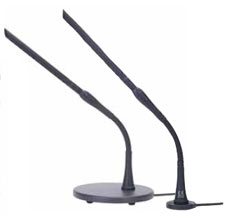Although frequently confused, a "lectern" and a "podium" are not the same. "Podium" begins with "pod," which is Greek for "foot"; a presenter stands on the podium, and places their notes on the lectern. The lectern is a stand, usually with a slanted top, used to hold a book, speech, manuscript, etc. at the proper height for a reader or speaker. AV lecterns may have builtin control surfaces to operate equipment, a clock, and a mounting plate for the ubiquitous lectern microphone.
Lectern microphones have gotten a bad wrap over the years because of the common cost-cutting practice of using an inexpensive gooseneck to support a handheld microphone. Cheap goosenecks squeak mercilessly when you position them, and a wooden lectern makes a great resonator cavity, which amplifies the noise both acoustically and then again when the microphone picks it up and sends it through the sound system. A handheld microphone on a gooseneck affixed to a lectern is not a lectern mic.
Some manufacturers have avoided the confusion by simply marketing "gooseneck microphones" - made to be used with, and usually permanently attached to, a flexible, high-quality gooseneck. The gooseneck can then be mounted to the lectern for handsfree, noise-free voice reinforcement.
DESCRIPTION: Microphones intended for lectern mounting.
APPLICATIONS: Permanent (or simi-permanent) attachment to a lectern for business, education, house of worship venues, or any place where formal spoken presentations are delivered on a regular basis.
SELECTION TIPS:
1. CHOOSE A CONDENSER-TYPE MICROPHONE. Condensers are more sensitive, and thus better for quiet talkers, and often produce a more natural voice quality on a wide variety of talkers. Plus, they are quite small compared to a typical handheld dynamic mics. Some hotels and rental companies traditionally supply a dynamic handheld in a lectern in case the user wants to remove the mic and walk around, but few users ever do.
2. LOOK FOR BUILT-IN RF IMMUNITY. This will minimize or eliminate the embarrassment of an executive's "Blackberry" or other device's RF signal getting into the sound system.
3. SELECT THE APPROPRIATE POLAR PATTERN. Most common is a cardioid pattern (120 degrees). This is the typical choice for most lecterns as it allows the talkers to move a little behind the lectern. A hyper-cardioid (100 degrees) will allow slightly greater distance between the talker and the microphone, allowing for higher gain before feedback. A shotgun mic (90 degrees) provides the narrowest pickup pattern, and is ideal where the talker is farther away from the mic.
4. ALWAYS USE THE FOAM WINDSCREEN, EVEN INDOORS. The sensitive nature of a small condenser microphone makes them susceptible to breath plosives (like "p-pops") if an untrained user speaks too closely into the mic. The foam windscreen can help minimize these noises. Windscreens can also minimize the pickup of air movement from HVAC systems, etc.
5. USE A SHOCK MOUNT. Avoid the classic "XLR connector mounted in the lectern," as it will transmit all of the lectern-pounding right up the gooseneck and into the mic.
6. SECURITY. Choose a "quick-mount" mic with built-in XLR connector if the user needs to take the mic away to prevent theft. This type of mic plugs directly into an XLR shockmount base.
7. USE ONLY ONE MIC ON A LECTERN. Although two (or even more) mics are often the norm for TV (think political speeches, corporate presentations, the President, the Pope, etc.) most often one of them is a simply a redundant spare, or is used to feed the broadcast pool, independent of the PA system. When two mics are active on a lectern, phase cancellation can occur as the talker shifts from side to side because the distance between the talker and mics is constantly changing. If two mics must be used, place the capsules as close together as possible.
8. BUY A QUALITY MICROPHONE. Better gooseneck mics have specially designed goosenecks that
can take a lot of flexing, don't make noise when flexed, and stay in place after they are positioned.
WHO MAKES THEM:
- AKG ACOUSTICS: www.akg.com
- AUDIO-TECHNICA: www.audio-technica.com
- AUDIX: www.audixusa.com
- AVLEX: www.avlex.com
- BEYERDYNAMIC: www.beyerdynamic-usa.com
- CROWN: www.crownaudio.com
- DPA MICROPHONES: www.dpamicrophones.com
- PEAVEY: www.peavey.com
- SENNHEISER: www.sennheiserusa.com
- SHURE: www.shure.com
Source: Audio-Technica
